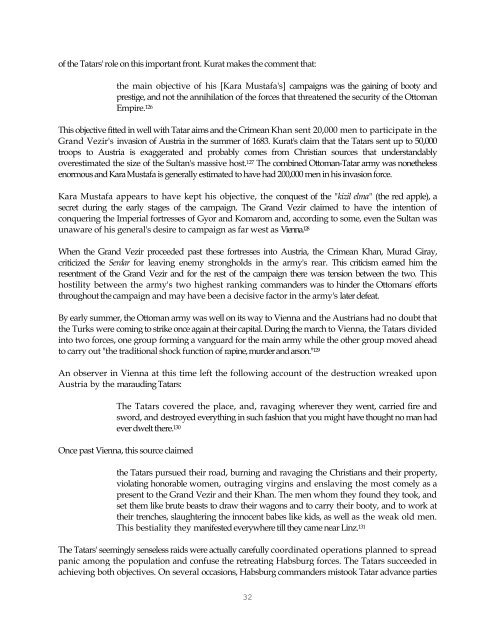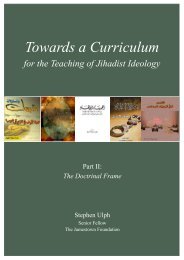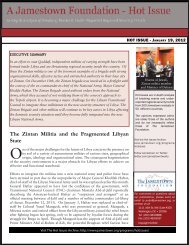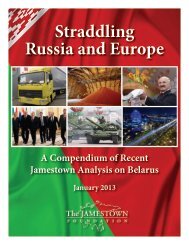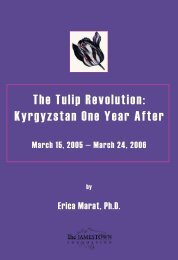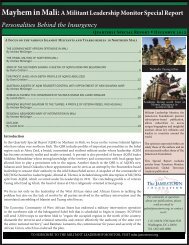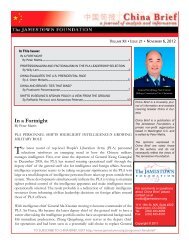By Brian Glyn Williams - The Jamestown Foundation
By Brian Glyn Williams - The Jamestown Foundation
By Brian Glyn Williams - The Jamestown Foundation
You also want an ePaper? Increase the reach of your titles
YUMPU automatically turns print PDFs into web optimized ePapers that Google loves.
of the Tatars' role on this important front. Kurat makes the comment that:<br />
the main objective of his [Kara Mustafa's] campaigns was the gaining of booty and<br />
prestige, and not the annihilation of the forces that threatened the security of the Ottoman<br />
Empire. 126<br />
This objective fitted in well with Tatar aims and the Crimean Khan sent 20,000 men to participate in the<br />
Grand Vezir's invasion of Austria in the summer of 1683. Kurat's claim that the Tatars sent up to 50,000<br />
troops to Austria is exaggerated and probably comes from Christian sources that understandably<br />
overestimated the size of the Sultan's massive host. 127 <strong>The</strong> combined Ottoman-Tatar army was nonetheless<br />
enormous and Kara Mustafa is generally estimated to have had 200,000 men in his invasion force.<br />
Kara Mustafa appears to have kept his objective, the conquest of the "kizil elma" (the red apple), a<br />
secret during the early stages of the campaign. <strong>The</strong> Grand Vezir claimed to have the intention of<br />
conquering the Imperial fortresses of Gyor and Komarom and, according to some, even the Sultan was<br />
unaware of his general's desire to campaign as far west as Vienna. 128<br />
When the Grand Vezir proceeded past these fortresses into Austria, the Crimean Khan, Murad Giray,<br />
criticized the Serdar for leaving enemy strongholds in the army's rear. This criticism earned him the<br />
resentment of the Grand Vezir and for the rest of the campaign there was tension between the two. This<br />
hostility between the army's two highest ranking commanders was to hinder the Ottomans ’ efforts<br />
throughout the campaign and may have been a decisive factor in the army's later defeat.<br />
<strong>By</strong> early summer, the Ottoman army was well on its way to Vienna and the Austrians had no doubt that<br />
the Turks were coming to strike once again at their capital. During the march to Vienna, the Tatars divided<br />
into two forces, one group forming a vanguard for the main army while the other group moved ahead<br />
to carry out "the traditional shock function of rapine, murder and arson." 129<br />
An observer in Vienna at this time left the following account of the destruction wreaked upon<br />
Austria by the marauding Tatars:<br />
<strong>The</strong> Tatars covered the place, and, ravaging wherever they went, carried fire and<br />
sword, and destroyed everything in such fashion that you might have thought no man had<br />
ever dwelt there. 130<br />
Once past Vienna, this source claimed<br />
the Tatars pursued their road, burning and ravaging the Christians and their property,<br />
violating honorable women, outraging virgins and enslaving the most comely as a<br />
present to the Grand Vezir and their Khan. <strong>The</strong> men whom they found they took, and<br />
set them like brute beasts to draw their wagons and to carry their booty, and to work at<br />
their trenches, slaughtering the innocent babes like kids, as well as the weak old men.<br />
This bestiality they manifested everywhere till they came near Linz. 131<br />
<strong>The</strong> Tatars' seemingly senseless raids were actually carefully coordinated operations planned to spread<br />
panic among the population and confuse the retreating Habsburg forces. <strong>The</strong> Tatars succeeded in<br />
achieving both objectives. On several occasions, Habsburg commanders mistook Tatar advance parties<br />
32


